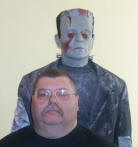

Ho Ho Horrors: Christmas Horror Films
 One hundred and eighty-two years ago on the 19th of December 1843, a
novella was published in London that would forever link the Christmas holiday
with the Horror genre. The release of Charles Dickens’ A Christmas Carol,
a tale of a series of holiday hauntings that serve to reform a miserly old man
into a philanthropist, was an overnight success, and has been credited with
reawakening the Victorian interest in celebrating Christmas, a tradition that
had largely died out in the industrialized urban areas of Britain. Since its
release, the story of Ebenezer Scrooge, the penny-pinching merchant who values
money above all else, and whose life is changed by a succession of ghostly
visitations on Christmas Eve, has become a holiday classic, with no fewer than
nineteen feature film adaptations, and dozens of television episodes that
borrowed the premise.
One hundred and eighty-two years ago on the 19th of December 1843, a
novella was published in London that would forever link the Christmas holiday
with the Horror genre. The release of Charles Dickens’ A Christmas Carol,
a tale of a series of holiday hauntings that serve to reform a miserly old man
into a philanthropist, was an overnight success, and has been credited with
reawakening the Victorian interest in celebrating Christmas, a tradition that
had largely died out in the industrialized urban areas of Britain. Since its
release, the story of Ebenezer Scrooge, the penny-pinching merchant who values
money above all else, and whose life is changed by a succession of ghostly
visitations on Christmas Eve, has become a holiday classic, with no fewer than
nineteen feature film adaptations, and dozens of television episodes that
borrowed the premise.
Though A Christmas Carol may be the best-known example of the conjunction between the Horror genre and Christmas, it’s far from the only one. There have been numerous Christmas-themed Horror films through the decades, with everything from Yuletide phantoms to Satanic Santas. An early example was a segment of the British film Dead of Night, released in 1945. A teenage girl (Sally Ann Howe) attending a Christmas party in an old country manor encounters a small boy, in tears because he believes his older sister wishes him dead. She calms the boy down and tucks him into bed, reassuring him that he’s safe. She mentions the boy to her hostess, only to be informed that the boy was, indeed, murdered by his sister—sixty years earlier.
But that was simply a ghost appearing at a Christmas party. What about the spirit of Christmas itself, jolly old St. Nick? Surely, there can be nothing horrific about Santa himself, could there? While there were some rather bizarre Cinematic Clauses in the 1960s, such as the Mexican film, Santa Claus, which was released in the US by K. Gordon Murray, or the equally odd Santa Claus Conquers the Martians, it would be 1972 before we would see Santa as a slasher, in Freddie Francis’ Tales from the Crypt. In the vignette “And All Through the House,” Joan Collins murders her husband on Christmas Eve, only to have a psychopathic Santa exact a chilling, karmic vengeance. Also airing in 1972 was the Made-for-TV movie Home for the Holidays, about an elderly man who summons his four daughters back home at Christmas to tell them that he believes that his new wife is trying to poison him. They start investigating their ‘stepmother’, but soon they find that they are being stalked by a mysterious killer in a yellow slicker.
As a decade, the 1970s were big for Christmas horrors, with the 1974 release of the prototypical Slasher film, Black Christmas. The tale of a faceless killer stalking the residents of a sorority over the Christmas holiday was one of the best horror films of 1974, and was the inspiration for a generation of calendar-based Slasher movies. Ten years later, another Santa-inspired slasher burst upon the scene, in Charles E. Sellier’s Silent Night, Deadly Night. Billy, whose parents were murdered in front of him, at Christmas time, has grown into a psychopathic adult who goes on a killing spree dressed in a Santa-suit.
Recently, there’s been resurgence in popularity of Christmas horrors, both of
low-budget Direct-to-Video, and theatrical releases. Movies such as Sint
(2011), and Krampus (2015), do more than dress killers in St. Nick’s
clothes; they deconstruct the whole mythology of Christmas, replacing it with
something dark and twisted. They have carried on the traditions of seeing the
darkness in this brightest of holidays, begun one hundred and seventy-five years
ago by Charles Dickens. For those who love Horror, and love Christmas, the two
make a winning combination.
I invite you to explore the Unimonster's other Crypt, which you'll find HERE!
![]()
Creature Feature © D. Dyszel 2025
Sponsored by